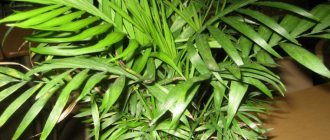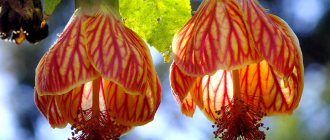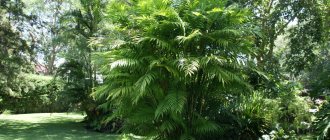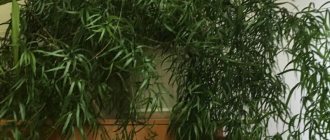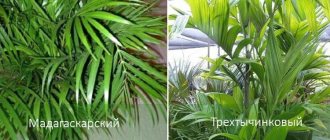Palm trees are strongly associated with the sun, sea, and beach. But not everyone is able to go on vacation when they want. Therefore, flower growers of the south - ficuses, rhododendrons, palms. The areas of modern apartments are such that it is impossible to place large plants in them; winter gardens and greenhouses are a rarity. The optimal solution is chamedorea. This low palm tree with fan leaves is unpretentious and successfully takes root in home conditions, so different from the tropics. It is only important to pay attention to some nuances of caring for the plant and spend time creating the desired microclimate.
What does the plant look like?
Chamaedorea is a fairly numerous genus belonging to the Arecaceae or Palm family (Arecaceae, Palmae, Palmaceae). The name is a combination of two Greek words: chamai (dwarf) and dorea (gift). In old sources the name “neanta” is also found
Hamedorea is highly valued by adherents of Feng Shui, who recommend having such a flower in every office. It is believed that this plant is able to neutralize negative energy, extinguish conflicts, fight melancholy, apathy, absent-mindedness, depression and stress. The owner of the chamedorea becomes more cheerful and cheerful, and looks at life more optimistically.
Most of the currently known 130 species of chamedoreas are low tree-like or bush-like palms with several trunks. But there are also epiphytic plants and even lianas.
Hamedorrhea at home does not look as impressive as in nature, but it is also very worthy
Hamedorea is native to the foothills of humid South and Central American forests. Most often they are found in Mexico, Belize, and Guatemala. Due to the characteristics of its habitat and appearance, Hamedorea has the nicknames “mountain”, “reed”, “bamboo palm”. In the United States it is known as Palma bella, meaning “beautiful.”
Flower growers value the plant for its large leaves (length from 30 cm to 2 m), symmetrically dissected along the central vein into individual “feathers”. The vein may sag in the middle. The shape of the leaves resembles fans. They are located on thin long trunks, similar to the stems of reeds or bamboo. The maximum diameter of the trunk is no more than 3 cm. Characteristic are transverse rings that appear in place of the lower leaves, which gradually fall off. The leaves are either collected in a “bouquet” or resemble a “crown” located at the top of the trunk.
Hamedorea blooms successfully at home, and flowers can appear at any time of the year. Quite inconspicuous velvety small yellow or orangish flowers randomly dot the peduncle. They are very reminiscent of mimosa. Since flowering has no decorative value, it is better to cut off the peduncle even before the buds form, so that the plant does not waste its energy.
Hamedorea flowers are not very attractive; if the goal is not to get seeds, the flower stalks are cut off, not allowing the buds to bloom
Like any palm tree - whether in natural conditions or “in captivity” - Hamedorea cannot boast of a growth rate. In nature, 70–80-year-old plants reach a height of 5 m or a little more; at home, they rarely grow above 1–1.5 m. This is especially true for specimens grown from seeds. At home, chamedorea grows more readily in width than in height. At the same time, its lifespan is practically unlimited. She dies only if the grower does not pay due attention to her and neglects the requirements for living conditions.
Hamedorea is a dioecious plant. This means the presence of specimens with only female (pistillate) and only male (staminate) flowers. Seeds are set on the first ones only under the condition of simultaneous flowering. Artificial pollination is also possible. You can distinguish pistillate plants by the light aroma of their flowers, which is absent in staminate plants. Inflorescences with male flowers are more voluminous and more branched.
Hamedorea is not only beautiful, but also useful. It has been scientifically proven that this plant is one of the leaders in absorbing carbon dioxide and releasing oxygen. Palm tree purifies the air from formaldehyde, trichlorethylene, and benzene. Moreover, harmful impurities are absorbed by both leaves and roots.
When purchasing chamedorea in a store, look for single plants - groups of seedlings closely planted in one pot are usually short-lived
Hamedorea palm - description
Hamedorea is an ornamental foliage plant. It is because of the beautiful feathery leaves that this palm tree is grown at home. Hamedorea flowers are devoid of brightness and decorativeness and are interesting only because they can bloom at any time of the year. They are small, slightly velvety, bright yellow in color, appear on the peduncle in random order along its entire length. Many gardeners generally recommend removing flowers at the budding stage, so as not to weaken the plant by flowering.
Dracaena at home - everything you need to know about care
What else should you consider if you decide to grow chamedorea at home? Get ready for the fact that this palm tree grows slowly, like other palm trees, especially for those specimens that are grown from seeds: it takes an incredibly long time for a sprout to hatch from a seed - it can “sit” motionless in the ground for more than six months.
In the photo: Growing Hamedorea in a pot
Well, the main thing you need to know before planting or buying chamedorea: it loves very humid air. And now about the issues of care in more detail.
Hamedorea graceful, Seifritz and others - types and their differences
Among the variety of chamedorea species, the following feel most comfortable at home:
- Hamedorea Arenberg (arenbergiana) or broadleaf (latifollia). The trunk is always single, with 5–10 leaves located on it at the same time. The maximum height of the plant is 1.6–1.8 m. The leaf cuttings are quite rigid, so they are straight, but individual “feathers” hang down. Leaf length is 30–35 cm, width is 8–10 cm. The flower tolerates even completely artificial lighting.
- Hamedorrhea high (elatior). New daughter plants are formed from one rhizome every year. Each of them has 4–6 leaves. The length of the leaf in nature is about 1.5 m, at home - about 1 m. The central vein is poorly expressed, so the leaves often bend and, as a result, dry out. Compared to other chamedoreas, the plant is tall - 4–5 m.
- Hamedorea geonomoformis (geonomiformis). Tree-like palm 1 m high or slightly higher. The leaves are gathered into a “crown” at the top. There are 6–8 of them in total. The length of each is about 25 cm, width - 12–15 cm. The deep dark green shade of the leaf blade is characteristic of the species.
- Hamedorea graceful (elegans), aka beautiful (bella), aka hitmilis. Many shoots resembling bamboo stems grow from a vine-like trunk, almost completely hidden underground. The height of the plant is 1.5–2 m. There are quite a lot of leaves – 24–28 at a time. In the middle, the central vein sags, so from the side they look like sickles. The flowers are pastel yellow, large for a chamedorea, with a pronounced aroma.
- Hamedorea stolonifera (stolonifera). It seems that many plants are closely planted in one pot, but these are separate thin shoots formed from one rhizome. At home, the palm tree grows up to 0.75–1 m. The leaf length is 20 cm, the width is half that. The flowers, unlike most chamedoreas, are bright orange.
- Hamedorea Ernest-Augusti (ernesti-augusti). A tree-like low (slightly more than a meter) plant with a thin trunk. A distinctive feature is the presence of aerial roots at the base of almost all internodes. The maximum number of leaves is 8–10. Leaf length is 55–60 cm, width is 20–25 cm. The leaf blade is solid, but deeply dissected (shape like a heart). Unlike other palm trees, it grows quite quickly and often blooms even at home. The flowers are orange-red or bright scarlet.
- Hamedorea unicolor (concolor). Plant height is 1.2–1.3 m. The leaves are small, light green in color. In a sufficiently spacious pot, over time, a whole “grove” will form, a continuous carpet of leaves. Only plants aged 70 years and older bloom.
- Chamedorea metallica (metallica). Similar to the previous view. It differs from the others in the shade of a very dense leaf plate - a rich dark green color, which from a distance appears almost black, but in the sun it shines glossy, like polished silver. The trunk of adult plants becomes woody. The species tolerates shade well. It is extremely rare for sale.
- Hamedorea bridbl. A selective hybrid, bred on the basis of Hamedorea graceica. He inherited the appearance of the “parent”, differing favorably from him in the size of the inflorescences, the brightness of the flowers and their aroma.
- Hamedorea Seifritz (seifrizii). Bushy plant. Leaves on long petioles. Individual “feathers” are spread out, the leaf resembles a fan. This palm tree is demanding of sunlight.
- Chamedorea cascade (cataractarum), also known as “cat palm”. The plant consists of many miniature palm trees. The leaves are light green, rather thin. The species is very sensitive to watering - it tolerates moisture deficiency worse than other chamedoreas, but when there is enough water, it quickly forms new daughter shoots and noticeably increases in growth.
- Hamedorrhea erumpens. The height of the plant is no more than 1 m. The leaves are soft and drooping. New shoots form at the roots at any time of the year.
Varieties
There are several varieties of Hamedorea that are grown at home. They are very similar in their methods of cultivation and care, but they have some differences in appearance and slight differences in growth and development.
Let's look at the most popular varieties of Hamedorea domestica:
Hamedorea gracilis
Hamedorea gracilis
- It is the most popular in the post-Soviet space, since it was one of the first to appear here. This is a relatively small plant with a maximum height of no more than one and a half meters.
- It has feathery leaves, which are characterized by the ability to bend. These arched leaves can range from 50 to 100 cm in length.
- They fit tightly to the trunks, the number of which is small.
- The plant cannot boast of beautiful flowering. The inflorescences are peculiar panicles, at the ends of which there are yellow spherical flowers.
- Sometimes their shade can reach yellow-green, and the petals are velvety.
- As noted earlier, it is recommended to get rid of flower stalks so that the plant does not waste resources on essentially useless flowering, but uses them for growth and increasing the number of shoots.
Hamedorrhea high
Hamedorrhea high
- This variety fully lives up to its name.
- With proper care, Chamedorea talla can grow from 3 to 5.5 m.
- Growing up, the plant loses its leaves and they leave marks on the trunk, making the trunk very similar to a bamboo plant.
- In fact, this variety is a long trunk with 5 to 7 large leaves growing at the top.
- The flowering, like that of Chamedorea graceful, is discreet, but the color is slightly different - instead of yellow it is orange.
Hamedorea metallic and Hamedorea Ernest-Augustus
Hamedorea metallic
- Varieties similar to each other, quite rare for our market of tropical crops. They have wide leaves, the segments of which are not divided. The leaf color is dark green and has a metallic tint.
- This appearance makes the plants very decorative and attractive to potential owners.
- It has a number of features, for example, a low growth rate - no more than 1-2 leaves per year.
- But the root system develops surprisingly quickly; the plant needs to be replanted every 2 years.
- It can grow even on heavy soils, where loams predominate.
- It blooms quite late - 4-5 years after transplantation. It blooms almost the same as the “graceful” variety, with the only difference being that the flowers are deep yellow, they are slightly larger, and are more densely located in the panicle inflorescence.
Microclimate for growing plants at home
The conditions to which Hamedorea is accustomed in its historical homeland differ sharply from the microclimate of modern apartments. Therefore, the “requirements” of the flower must be treated with understanding and, if possible, satisfied:
| Factor | Recommendations |
| Location | The plant is suitable for both a window sill and a place in the back of the room. An ideal area is 1–1.5 m from a window facing south or east. Rotate the chamedorea every 1.5–2 weeks so that the leaves develop evenly and the plant becomes symmetrical. In summer, the pot can be taken out into the garden, onto the terrace, or balcony. The only condition is the presence of protection from direct sunlight, wind and rain. |
| Lighting | Penumbra or bright but diffused light. If exposed to direct sunlight from 10:00 to 17:00, shade the plant. |
| Air humidity | The higher the better. The minimum indicator is 50%. Spray the flower 2–3 times daily, ventilate the room, wipe the leaves with a damp sponge every 10–12 days, or give the flower a shower. Place several vessels with water, containers with wet moss, expanded clay, or a special humidifier device nearby. |
| Temperature | In summer, the optimal temperature is 22–27ºС (or slightly higher). More than 30ºС is no longer desirable. In winter - about 15ºС (this applies to both air and soil). When the thermometer is below 12ºC, chamedorea dies. |
Hamedorea can be placed not only on the windowsill, but also anywhere else in the room
Description of the variety and photo
Hamedorea "Bridble" is a tropical guest, planted as a houseplant in central Russia. This palm tree looks attractive, is considered to bring good luck in Feng Shui techniques, and helps to diversify the decor in the interior.
Under favorable conditions, the plant forms a lush green mass, looks very decorative, and can become a real decoration of the interior space.
Among the main characteristics of the Bridble Hamedorea palm are:
- stems are creeping, green (adults turn brown);
- multiple thin fronds - shoots;
- pinnate arcuate leaves on a long petiole;
- leaf blade consisting of 12 or more lobes;
- paniculate inflorescences consisting of spherical yellow flowers;
- berry-like fruits, spherical, deep black in color.
Chamaedorea Breedblading is an edible plant.
In its natural environment in South and Central America, it is used in the preparation of salads. Unopened buds, fruits, and leaves are used for culinary purposes. Since chamedorea
not
grow quickly
, but very slowly, the first containers for sprouted seedlings are chosen to be small in size; it is permissible to plant two or even three sprouts in one pot.
Hamedorea Bridble and Elegance - differences
A fairly well-known variety that is a hybrid. Bridble is similar in appearance to its parent plant, Hamedorrhea graceica, with the exception of some differences:
- Bridble has emerald leaf color;
- larger flower size;
- flowers exude a pleasant aroma.
How it blooms
The inflorescences are axillary paniculate, consisting of small spherical fragrant flowers of yellow and orange-red shades. In appearance, they resemble the familiar mimosa. The flowering period is the summer months, starting from 3-4 years of age.
This is a dioecious crop, that is, to obtain seeds you need male and female specimens.
The fruits are spherical berries, about 6 mm in size , black in color with an orange stalk. Each berry contains one seed.
After purchasing in store
A week to ten days after purchase, when the flower has become accustomed to the new conditions, it needs to be replanted in nutritious fresh soil (usually soil in pots with plants intended for sale, cheap and depleted in nutrients). It is best to purchase soil for palm trees in a specialized store , but you can create a substrate for Hamedorea bridble yourself. To do this, mix:
- clay-turf soil - 2 parts;
- deciduous soil - 2 parts;
- clean sifted sand - 1 part;
- peat - 1 part;
- rotted manure - 1 part.
Planting and transplanting procedure
Young chamedoreas under the age of 5 years are replanted annually. Mature palm trees - only when the need arises (roots are visible from the drainage hole). As a rule, this happens once every 3–4 years. The best time for the procedure is from early to mid-spring. If the flower has reached such a size that it is physically impossible to replant it, limit yourself to replacing the top layer of soil in the pot (4–5 cm).
The new container should be approximately 7–10 cm wider than the previous one. Choose tall and narrow ceramic pots or wooden planters. The root system of chamedorea should go deep into the ground. The presence of a large drainage hole is an additional plus.
Hamedorea, like any palm tree, feels best in a classic tub or in a bucket-like pot
There is a special soil mixture for palm trees, but you can make your own substrate:
- fertile turf, universal soil for indoor plants, leaf humus, coarse river sand (3:2:2:1);
- fertile turf, humus, peat chips, perlite or vermiculite (equal parts);
- soil for palm trees and any “leaving agent” - finely chopped sphagnum moss or coconut fiber, sawdust from coniferous trees, brick chips, crushed tree bark, pieces of pumice (5:2).
Hamedorea is replanted only by transshipment. Any palm tree reacts very negatively to exposed roots.
- Fill the bottom of the new pot with drainage. The layer thickness is at least 5 cm. Then add twice as much sterilized soil.
- Moisten the substrate well and remove the plant from the pot, trying to destroy the earthen ball as little as possible.
- Using a sharp, clean knife, cut off the thin roots from below, which have rolled into a solid lump that looks like felt.
- Place the chamedorea in a new pot and add soil around the edges. Compact the soil well. You cannot bury the plant deeper than in the old container.
- Water the flower a little with warm water. For 10–12 days, protect the palm tree especially carefully from direct sunlight.
Hamedorea is replanted only when the roots have completely mastered the space provided to them.
Video: Replanting Hamedorrhea
Signs and superstitions
There are a lot of signs and superstitions associated with growing mountain palms:
- It is accepted that chamedorea growing in the house gives its owners peace of mind and confidence, and increases self-esteem.
- Selfish natures will have to refuse to purchase a flower. Otherwise, they will become completely unresponsive to others.
- The flower provides certain benefits to people of various professions. For example, it will help athletes win and reach new heights, people in creative professions will receive recognition, and businessmen will bring their projects to life.
- Possessing powerful energy, the mountain palm has a positive effect on a person’s destiny, helps to achieve success in any direction, and prevent family quarrels.
- A pot with a plant scares away energy vampires and cleanses the aura.
Hamedorrhea can also have a negative effect. According to popular belief, if you place a pot in the house, disaster will happen. To prevent such consequences, the flower must cross the threshold of the house not in the hands of a person , but on wheels. This could be, for example, a stroller or cart.
The plant has a beneficial effect on the atmosphere in the house only when its inhabitants have pure intentions. Otherwise, it is better not to purchase the flower, because... he may die.
So, chamedorea needs specific care at home. Compliance with the instructions for the maintenance of this exotic plant is the basis for its healthy growth. The main thing is to provide it with a sufficient amount of light, optimal humidity and timely feeding, and take care of the availability of the necessary space in the room.
Sources
- https://1pocvetam.ru/komnatnye-rasteniya/xamedoreya-2.html
- https://krrot.net/xamedoreya-domashnya/
- https://komnatnie-rastenija.ru/hamedoreja-vyrashhivanie-i-uhod-v-domashnih-uslovijah-foto-vidov/
- https://RoomFlower.ru/komnatnye-tsvety/palmovye/hamedoreya-ehlegans.html
- https://fermer.blog/bok/komnatnye-rasteniya/dekorativno-listvennye/palmy/4449-hamedoreja-bridbl.html
- https://ProZvety.ru/katalog-rastenij/palmovye/hamedoreya-uhod-v-domashnih-usloviyah
- https://greensotka.ru/palmy/hamedorea-uhod-v-domasnih-usloviah.html
- https://vashehobbyrf.ru/chamaedorea-elegans/
- https://floristics.info/ru/stati/1631-khamedoreya-v-domashnikh-usloviyakh.html
- https://stroy-podskazka.ru/komnatnye-cvety/hamedoreya-izyashchnaya/
- https://stroy-podskazka.ru/komnatnye-cvety/hamedoreya/
- https://kaktys.club/uhod/palmy/hamedoreya-uhod-v-domashnih-usloviyah
- https://room-plant.ru/komnatnye-rasteniya/dekorativno-listvennye/vyrashhivanie-hamedorei-v-domashnih-usloviyah/
- https://sait-pro-dachu.ru/palma-xamedoreya-kak-ee-razmnozhat-v-domashnix-usloviyax/
- https://moyasotka.com/tsvety/komnatnye/palmovye/hamedoreya-uhod-v-domashnih-usloviyah.html
- https://rastenievod.com/hamedoreya.html
- https://rastenievod.com/hamedoreya-izyashhnaya-elegans.html
- https://floriums.ru/hamedoreya-elegans
- https://palma-doma.ru/uhod/hamedoreya/
- https://zen.yandex.ru/media/id/5bd6b0a11d6b0a00ab5b6110/samaia-neprihotlivaia-palma-hamedoreia-uhod-i-vozmojnye-problemy-pri-vyrascivanii-iziascnoi-neanty-5c00a4848580c6049c4f0cda
- https://cvetokmir.ru/hamedoreja-bridbl-uhod-v-domashnih-uslovijah.html
- https://prorasteniya.com/komnatnye/palmy/hamedoreya.html
[collapse]
Important nuances of caring for a reed palm
The dormant period of chamedorea is poorly expressed, so winter and summer plant care differ little.
Watering
Watering is the main component of chamedorea care. It will survive overdried soil for some time, but will react sharply negatively to a waterlogged substrate. The plant prefers to obtain the necessary moisture from the air rather than from the soil.
In summer, chamedorea is watered abundantly every 3-4 days. A layer of substrate to a depth of 3–4 cm should dry completely. A clear sign indicating excessive watering is the unpleasant smell of dampness and rot coming from the soil. In winter, the intervals between waterings are increased to 4–6 days.
For watering and spraying, use soft water heated to a temperature slightly above room temperature (about 30ºC). If it is not possible to water the flowers with rain or melt water, leave the tap water for at least a day. To neutralize calcium compounds, add a few citric acid crystals to the container.
Fertilizer application
Hamedorea, compared to other palm trees, requires more fertilizer. But if the flower is transplanted at the wrong time, especially in autumn or winter, fertilizing begins only next spring. The same applies to store-bought and transplanted plants, as well as chamedoreas obtained vegetatively. They are fertilized for the first time no earlier than 3–4 months after transplantation.
Hamedorea is fed only during the active growing season - from mid-spring to late summer. One feeding every 15–20 days is enough. If you are satisfied with the condition of the palm tree and the growth rate, apply fertilizer once a month. In winter, fertilizing is excluded.
Whenever possible, choose fertilizers that come in the form of long-dissolving granules that are applied dry to the soil. If there is no alternative, liquid complex mineral fertilizer is also suitable. In addition to root feeding, you can spray the leaves with fertilizer, reducing the concentration of the product by three times. Just don’t use organics - it’s unknown how an exotic plant will react to such unusual means.
Diseases
Hamedorea rarely suffers from pests or other ailments because it is easy to care for. Flower growers face only a few problems:
- Chlorosis. Appears due to poor soil composition and lack of iron. During this disturbance, light spots appear on the leaves. It is enough to choose a fertilizer with a high content of this element to get rid of the problem.
- Root rot. Appears due to excess moisture and too frequent watering. The photo shows what the disease looks like. During this, the roots simply do not have time to absorb all the moisture, so rotting begins. To get rid of this, you will have to remove all the affected areas and cover the roots with charcoal powder.
Table: Disease treatment and insect control
| Problem | External manifestations | What to do? |
| Shchitovka | At first almost flat, then swelling elliptical growths of all shades of brown; reddening or yellowing areas of tissue around them; black soil in a pot. | Prevention:
Struggle:
|
| Spider mite | Small dark dots are punctures on the leaves and discolored areas of tissue around them; dried, curled leaves, braided with thin, almost transparent threads. | Prevention:
Struggle:
|
| Mealybug | Leaves covered with a white coating similar to shreds of cotton wool and sticky transparent secretions, especially on the underside; soil coming off the edges of the pot; a ring of whitish, waxy coating in this place. | Prevention:
Struggle:
|
| Thrips | A scattering of small brown dots on the leaves, clearly visible in the light; in especially severe cases - silver stripes or mesh on the leaf plate. | Prevention:
Struggle:
|
| Fusarium | Losing tone, drooping leaves, yellow blurry spots on the leaf plate; completely yellowed lower leaves; thinned stems. If the disease is not dealt with, the spots turn brown and a characteristic smell of rot appears. | Prevention:
Struggle:
|
| Late blight | Rapidly spreading lilac-brown spots on leaves and stems, gradually turning black and softening tissue in these places. The appearance of a putrid odor. | Prevention:
There are no effective measures to combat the disease. If it is detected early, replanting while pruning all parts of the plant that appear to be infested can help. Then, for 3–4 months, the flower is watered every 2–3 days with a 1% solution of any fungicide, Alirin-B, Previkurt. |
Photo gallery: Diseases and pests
The scale insect has a dense shell, so not all insecticides are effective against the pest.
To combat spider mites, special preparations are used - acaricides.
If you don’t fight the mealybug, the plant will soon be covered with a continuous layer of whitish plaque.
Thrips are flying insects, so they are easy to spot: just shake the flower
A plant suffering from fusarium wilts and dies in a matter of days.
Late blight is very similar to rot
What can stop a palm tree from growing?
Howea palm - home care
If improperly cared for, there is a high risk of the plant becoming infected with spider mites. The result of its activity immediately appears in the form of yellow spots on the leaves. The disease occurs due to waterlogged soil. If the plant was initially planted in incorrectly selected soil, which after watering does not breathe and turns sour, the pest will not take long to reproduce. Under such conditions, another source of the disease may appear - scale insects. When it appears, the leaves acquire dark plaques.
Souring of mail is dangerous due to the manifestation of pink rot, in which the roots die, followed by the entire plant. If pink spots begin to appear on the trunk of a palm tree, this is a reason to urgently change the soil. After falling out of the pot, the damaged roots are cut off, the remaining lump of earth with its roots entangled is treated with a fungicide.
What does scale insect look like on palm leaves?
When gray oval spots appear on the leaves, you have to fight a fungal disease caused by excessive watering. At the first signs of infection, damaged leaves should be cut off, healthy leaves should be treated with a fungicide solution.
When a plant is densely overgrown and has a large number of leaves, between which air circulates poorly, there is a high probability that aphids will soon be found among the greenery. A small insect of a juicy green color is perfectly camouflaged in the thickets of a palm tree and causes significant harm to its health. To prevent aphids from appearing, you need to timely divide a dense bush into several small ones.
Features of reproduction
Hamedorea is unique among palm trees in that it reproduces not only by seeds, but also vegetatively (by daughter shoots). Amateur flower growers, as a rule, do not experience a shortage of planting material.
Germination of seeds
Hamedorea seeds are easy to purchase, but be sure to pay attention to the expiration date
Hamedorea seeds ripen for about 6 months, then quickly lose their viability. Getting them at home is quite problematic, so when purchasing, always pay attention to the expiration date. Every month the number of specimens capable of germinating decreases by approximately 10%. Therefore, already 10 months after collection, the purchase is impractical. Hamedoreas obtained from seeds grow more slowly than usual, but the plants do not inherit diseases from the “parent”.
- 7–8 days before planting in the ground, soak the seeds in water or Zircon solution, maintaining the temperature of the liquid at 30–35ºС.
- Carefully remove the outer fleshy membrane. Using a thin file, needle file, or nail file, make a cut in the hard shell, do not remove it.
- Fill plastic cups with a mixture of peat or finely chopped sphagnum moss and steamed sawdust with coarse river sand (all ingredients should be taken equally). Moisten the soil with a spray bottle.
- Place the seeds on the surface of the substrate (add 2-3 pieces to each cup), press down 1-1.5 cm. Do not pour on top. Cover with plastic wrap.
- Provide a constant temperature of 29–32ºС, humidity within 90–100%, protection from direct sunlight, and, if possible, bottom heating. Remove the plastic for 2-3 minutes every day. Under suitable conditions, seedlings will appear in just over a month, but the procedure can take 3–6 or even 9 months.
- When the first true leaf reaches a length of 4–5 cm, transplant the chamedoreas into separate pots. Substrate - fertile turf, river sand, leaf soil, humus (2: 2: 1: 1). Every day, gradually increasing the period of time, place the seedlings at their future “place of registration” so that they get used to the new conditions. Maintain a temperature of at least 25ºC and high humidity. Spray young plants 2-3 times a day.
- After 4-5 months, transplant the chamedoreas into soil for adult plants and care for them as usual.
Prerequisites
It is always necessary to monitor the soil.
You can purchase a ready-made composition that is suitable just for palm trees. You can prepare the substrate yourself. To do this, you need to mix 2 parts each of a fibrous peat substrate, fresh humus and turf-type soil. Then add another 1 part of sand (fractions should be medium). The correct composition of the soil is a very important component, since only light and loose soil will ensure the normal development of the plant thanks to ventilation. In addition, this will prevent soil acidification
It is imperative to make drainage; for this, elements of the middle fraction are also needed. For example, broken ceramics, pebbles, polystyrene foam, and expanded clay are suitable.
Pouring soil for replanting
In addition, it is very important to choose the right container. It should be voluminous
It is best to choose one that is quite tall. The height of the container should be greater than its width. This is due to the fact that the roots should not diverge to the sides, but go deeper. Clay pots work great. You can also use tubs made of wooden boards. Not only are these natural materials breathable, but they can also add beauty to a room.
It is necessary to fertilize the soil periodically. At home, without feeding, chamedorea simply will not survive and will not be able to fully develop. A natural fertilizer called “Palm” is perfect for it. Its manufacturer is . This solution is very concentrated. It is prepared on the basis of natural ingredients, using waste from earthworms. The product contains potassium, phosphorus and nitrogen in optimal quantities, which is ideal for chamedorea. Feeding should be applied several times a year, and the frequency will vary. The first period occurs from the beginning of March to the end of September.
When and how does it bloom
Hamedorea flower - leaves dry, what to do
Hamedorea begins to bloom only 4-6 years after planting. Further, the appearance of inflorescences is observed every 1-2 years.
Palm blossom
- Types of flowers. The inflorescences are distinguished by a single color of orange or yellow. During the flowering period, a pleasant and delicate aroma emanates from the palm tree.
- Flower shapes. The inflorescences form into small panicles, which in appearance resemble beads on a branch.
- Flowering period. The plant begins to bloom in the spring and summer months. The dormant period begins in October.
- Changes in care during the flowering period. During the growing season it is necessary to carry out regular fertilizing and watering. Gardeners recommend preventative pruning, during which it is necessary to remove dried branches. This will help avoid obstacles to the appearance of new flowers.
Trimming
The plant should be thoroughly inspected and pruned annually. During the process, it is recommended to remove dried leaves that have a yellow tint and irregular shape. For the procedure, you must use sharp scissors or pruners. After pruning, the stems are treated with a fungicide.
Why does chamedorea dry out and the leaves turn yellow?
Some do not bloom, as in the picture; on the contrary, the plant begins to dry out and turn yellow. The question arises why the leaves are dry and what to do. If this is observed after transplantation, then this phenomenon can be considered temporary. When the lower leaves die off, there is no need to worry as this is a natural process.
When the mass dries out, overdrying can be suspected. If only the tops are affected, watering should be reduced. It is recommended to do the same for limp plants with black leaves. In addition, it is recommended to check whether the roots have rotted.
Fortune telling and superstitions are associated with the Hamedors. People believe that a pot with a palm tree should not be brought into an apartment because it will cause trouble. To avoid trouble, it should be placed, for example, in a carriage. Of course, these are all superstitions.
Just the sight of a blooming palm tree is enough to lift your spirits. Small yellow flowers will create a summer atmosphere in the house and will delight the owner.
Plant diseases and pests
With proper care, chamedorea will not get sick. Excessively dry air always harms the palm tree and causes the spread of spider mites. Improperly cared for palms can be attacked by mealybugs and lepidoptera. To prevent these problems, it is recommended to take a warm shower with soapy water on the leaves.
Root rot can occur due to overwatering. This disease is fungal in origin and should be treated with fungicides.
